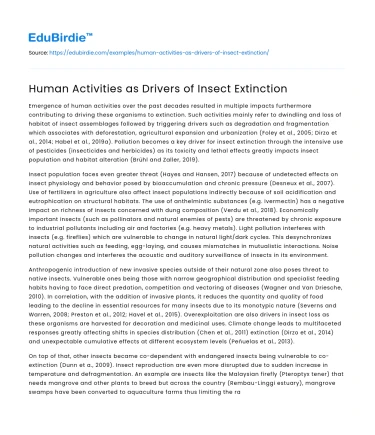Emergence of human activities over the past decades resulted in multiple impacts furthermore contributing to driving these organisms to extinction. Such activities mainly refer to dwindling and loss of habitat of insect assemblages followed by triggering drivers such as degradation and fragmentation which associates with deforestation, agricultural expansion and urbanization (Foley et al., 2005; Dirzo et al., 2014; Habel et al., 2019a). Pollution becomes a key driver for insect extinction through the intensive use of pesticides (insecticides and herbicides) as its toxicity and lethal effects greatly impacts insect population and habitat alteration (Brühl and Zaller, 2019).
Insect population faces even greater threat (Hayes and Hansen, 2017) because of undetected effects on insect physiology and behavior posed by bioaccumulation and chronic pressure (Desneux et al., 2007). Use of fertilizers in agriculture also affect insect populations indirectly because of soil acidification and eutrophication on structural habitats. The use of anthelmintic substances (e.g. Ivermectin) has a negative impact on richness of insects concerned with dung composition (Verdu et al., 2018). Economically important insects (such as pollinators and natural enemies of pests) are threatened by chronic exposure to industrial pollutants including air and factories (e.g. heavy metals). Light pollution interferes with insects (e.g. fireflies) which are vulnerable to change in natural light/dark cycles. This desynchronizes natural activities such as feeding, egg-laying, and causes mismatches in mutualistic interactions. Noise pollution changes and interferes the acoustic and auditory surveillance of insects in its environment.
Save your time!
We can take care of your essay
- Proper editing and formatting
- Free revision, title page, and bibliography
- Flexible prices and money-back guarantee
Anthropogenic introduction of new invasive species outside of their natural zone also poses threat to native insects. Vulnerable ones being those with narrow geographical distribution and specialist feeding habits having to face direct predation, competition and vectoring of diseases (Wagner and Van Driesche, 2010). In correlation, with the addition of invasive plants, it reduces the quantity and quality of food leading to the decline in essential resources for many insects due to its monotypic nature (Severns and Warren, 2008; Preston et al., 2012; Havel et al., 2015). Overexploitation are also drivers in insect loss as these organisms are harvested for decoration and medicinal uses. Climate change leads to multifaceted responses greatly affecting shifts in species distribution (Chen et al., 2011) extinction (Dirzo et al., 2014) and unexpectable cumulative effects at different ecosystem levels (Peñuelas et al., 2013).
On top of that, other insects became co-dependent with endangered insects being vulnerable to co-extinction (Dunn et a., 2009). Insect reproduction are even more disrupted due to sudden increase in temperature and defragmentation. An example are insects like the Malaysian firefly (Pteroptyx tener) that needs mangrove and other plants to breed but across the country (Rembau-Linggi estuary), mangrove swamps have been converted to aquaculture farms thus limiting the range of firefly dispersal.
Did you like this example?
Make sure you submit a unique essay
Our writers will provide you with an essay sample written from scratch: any topic, any deadline, any instructions.
Cite this paper
-
APA
-
MLA
-
Harvard
-
Vancouver
Human Activities as Drivers of Insect Extinction.
(2022, November 25). Edubirdie. Retrieved December 25, 2024, from https://edubirdie.com/examples/human-activities-as-drivers-of-insect-extinction/
“Human Activities as Drivers of Insect Extinction.” Edubirdie, 25 Nov. 2022, edubirdie.com/examples/human-activities-as-drivers-of-insect-extinction/
Human Activities as Drivers of Insect Extinction. [online].
Available at: <https://edubirdie.com/examples/human-activities-as-drivers-of-insect-extinction/> [Accessed 25 Dec. 2024].
Human Activities as Drivers of Insect Extinction [Internet]. Edubirdie.
2022 Nov 25 [cited 2024 Dec 25].
Available from: https://edubirdie.com/examples/human-activities-as-drivers-of-insect-extinction/
copy






 Stuck on your essay?
Stuck on your essay?

